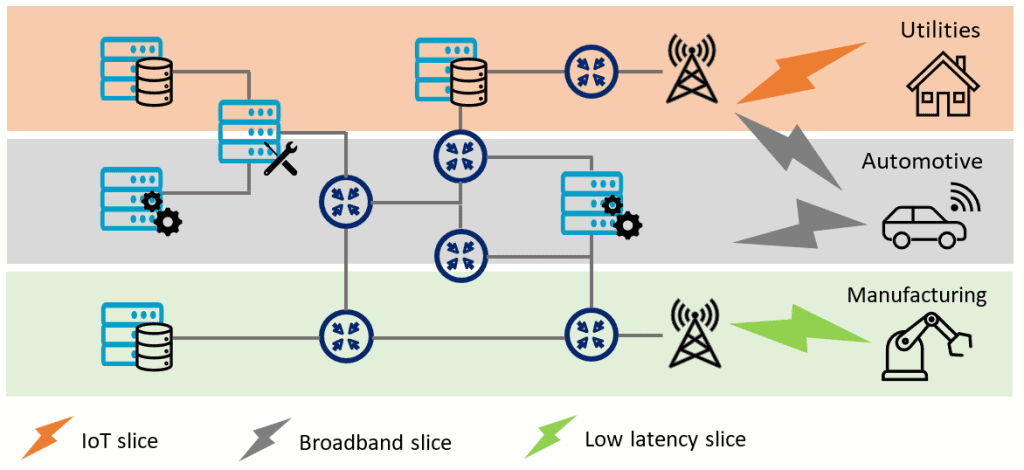Introduction
5G is set to transform society as we know it, changing the way we communicate and live our lives. Its core network is designed to provide innovative capabilities such as Enhanced Mobile Broadband (eMBB), Massive Machine-Type Communication (mMTC), and Ultra-Reliable Low-Latency Communication, Catering to everyone from smartphones to robots and advancing mobile technology for years to come.
5G is also revolutionizing the way we interact with our network. While previous generations of mobile networks provided basic QoS levels for different services, 5G takes this to a whole new level. It is a smarter, more flexible network that can be tailored to specific customers’ needs. 5G is designed to serve multiple industries and use cases, each with its own different requirements.
Tailored services in 5G are enabled through network slicing, which is projected to be a significant revenue generator for operators in the future. Network slicing divides the network up into virtual slices. Each slice will come with its own guaranteed SLAs depending on the particular service requirement. Network slicing will enable you to prioritize network resources, improving its operational efficiency and time to market to deliver 5G network services. As operators will be selling virtual slices to different enterprises for a specific purpose, they’ll need to guarantee the quality of service and contracted SLAs of each network slice.
What exactly is network slicing, and why do operators need this capability to deliver a smarter 5G network?
Network Slicing: Tailor Your Network Based on Customers’ Needs
Network slicing enables operators to take their network and divide it up into virtual slices that all run on a common physical infrastructure. Each network slice is a virtually isolated network that delivers pre-defined network capabilities and characteristics designed to serve a specific customer’s business purpose. Service quality and SLAs should be guaranteed at a per-slice level. For example, a virtual slice for mobile broadband would guarantee capacity and performance (say for video streaming), whereas a slice for machine-to-machine communications would guarantee connectivity. As the slices are isolated from each other, an error or fault in one slice does not affect other slices’ communication.

Within each network slice, all the components that make up a communication proposition- such as latency, bandwidth, processing power, storage, security model, and others- can all be pre-defined by a customer use case, apportioning every feature and level of functionality of the service offered to meet contracted SLAs. This enables the network to prioritize its resources more efficiently and tailor them based on each customer’s performance, functionality, and operational needs.
Furthermore, while QoS can differentially treat different types of traffic, such as web browsing and VoLTE, it cannot give priority to the same kind of traffic coming from other sources. With network slicing, if the same type of traffic (e.g., web browsing) is assigned to different slices, it can be treated differently. Thus, network slicing is the cornerstone to a smarter, more flexible network that can be tailored to specific customers’ needs.
As operators are investing heavily in their transition to 5G networks, they need to work out ways to also generate revenues. According to GSMA, network slicing will be worth USD 300 billion to operators globally by 2025[i]. Operators will tap into new customers and extend their business areas by leasing multiple virtual networks while still operating on a single physical infrastructure.
Furthermore, network slicing’s flexibility is unprecedented: A network slice can be dedicated to a single industry vertical or shared by multiple verticals. Also, multiple slices of different types may be bundled into a single product targeted towards customers who have diverse requirements. Vertical industries such as utilities, automotive, manufacturing, and AR/VR are all commercial ROI opportunities that require their own customized network.
The Challenge of Monitoring End-To-End Network Slices
A network slice can span across the network end-to-end, crossing the RAN, edge, transport, and core. The ability to visualize, monitor, and assure the quality of services across all these domains is indispensable, yet it presents a significant challenge to operators.
Furthermore, in some use cases, a network may be divided into countless virtual network slices. You will be required to monitor and analyze traffic performance KPIs of each network slice, guaranteeing pre-defined SLAs and assuring the quality of service. As an operator, you will need advanced slice monitoring and assurance capabilities to ensure the quality of service and KPI metrics at a per-slice level.
The deployment of automated assurance will be critical for advanced network slice management. Assurance continuously monitors each virtual slice, mapping every XDR/KPI/KQI to the relevant service slice to understand the overall QoE and QoS and confirm compliance to SLAs. If SLAs aren’t being met, alerts and alarms can be set to notify if anomalies are detected and/or if any service level requirements are breached. Engineers can use KPI/KQI dashboards to monitor their slices and drill down from a macro to a micro view using tracing tools to perform an in-depth analysis of the network slice performance and perform root cause analysis of any degradations in service. Automated assurance enables the quick and effective validation of network and service performance, isolates network degradations, and proactively pinpoints the root cause.
Capabilities include:
- Visibility into your network slices and their QoS/QoE
- Advanced troubleshooting and root cause analysis to find and resolve issues quickly
- Proactive and continuous monitoring of QoE and QoS to confirm SLAs.
As an additional step towards full automation, operators can move to a closed-loop approach to managing their network slices by deploying automated assurance based on a Network Data Analytics Function (NWDAF).
The Solution: Integrate Assurance with NWDAF for Closed-Loop Automation
To move to a more automated approach to manage network slicing, operators can make their network smarter and more adaptive with an NWDAF solution that integrates with the 5G Core, OAM, and network orchestration to monitor and analyze network slices spanning the RAN, edge, transport, and core network domains. Such dynamic assurance and orchestration are critical to automating each slice operation starting with its initial design throughout its entire life cycle management.
NWDAF continuously monitors the network end-to-end, providing advanced analytics to other 5G Core NFs, such as real-time KPIs and KQIs, detecting anomalies that have occurred in the network slice, and even predicting the future behavior of network slices using AI and Machine Learning (ML). KPIs and KQIs are also compared to the SLA promised for each slice, and an alert is generated in case of a substantial deviation from SLAs. This invaluable
analytic data triggers corrective action in 3rd party Core NFs to resolve issues that are already occurring or, better still, mitigate a predicted issue before it affects users.
The Network Data Analytics Function (NWDAF), as defined in 3GPP Releases 15 and 16, incorporates standard network interfaces from the service-based architecture to collect data from other network functions, perform advanced network analytics, and deliver analytics over standardized interfaces to other NFs, AFs, and OAM functions in the network to enable closed-loop automation.
While 3GPP standards focus on data collection from 3rd party NFs via Subscription/ Notification APIs, RADCOM’s NWDAF provides data collection capabilities that go above and beyond 3GPP standards and support a vast range of data sources, including standard and proprietary event streams and/or packet feeds, in addition to the Subscription/Notification based event collection.
One of the first use cases defined for the NWDAF framework is focused on monitoring network slicing load levels and Quality of Service. The NWDAF identifies the load level in each network slice instance and creates slice utilization KPIs provided to 3rd party NFs, such as the PCF (Policy Control Function) and NSSF (Network Slice Selection Function) per network slice instance.
In addition to providing real-time Network Slice KPIs, NWDAF can automatically alert 3rd party network components. The NSSF, PCF, AMF, and other NFs or OAM components such as Orchestrators and Cloud Infrastructure Managers (CIMs) use the analytics provided by NWDAF to mitigate current or predicted slice congestion by connecting new users to alternative slices, diverting traffic from congested slices to non-congested slices, by scaling out or scaling up NF clusters or by assigning additional resources to the overloaded network functions.
NWDAF’s automated Network Slice management is not limited to slice load levels only. RADCOM’s NWDAF solution continuously monitors a plethora of performance and quality indicators that measure subscribers’ quality of experience, from download and upload speeds and latency to buffering duration measured for encrypted video streaming using AI/ML technology.
The NWDAF can utilize each KPI and KQI to detect and predict anomalies and deviations from SLA and trigger automated closed-loop corrective action as described above. When used with built-in AI/ML capabilities, NWDAF will provide you with automatic, data-driven adjustments and insights not possible to reach through manual network monitoring.
By deploying a solution that combines automated assurance and NWDAF, you can gain two solutions in one; a centralized analytics function and assurance that provides end-to-end network troubleshooting and complete service and customer experience visibility— empowering the operator with an enhanced, more agile NWDAF solution. This will enable you to monitor and troubleshoot your network slices at a service-level and not just a network-level to improve the overall customer experience.
Summary
In conclusion, network slicing is a crucial capability in 5G networks that offers a critical revenue stream to operators while providing customers with guaranteed service quality for multiple use cases. Assuring network slicing is part of our advanced assurance solution, RADCOM ACE, which enables operators to monitor each slice performance in real-time and across all domains to ensure their full lifecycle optimization.
As well as slice assurance and advanced troubleshooting, RADCOM ACE can also help operators move to a closed-loop approach to managing their network slices by deploying automated assurance based on a Network Data Analytics Function (NWDAF). This collects, correlates, and aggregates data per slice from multiple data sources, detecting slices with reduced QoE to optimize orchestration of network capacity. With integrated AI/ML capabilities, RADCOM ACE is able to automate this entire process, reducing operational costs while still assuring superior customer experience. When integrated into the network, it will enable you to launch and manage a smarter and adaptive 5G network.
To learn more about RADCOM ACE for an enhanced network slicing capability, download our white paper about AI Driven-Assurance for 5G.
[i] Network Slicing, Use Case Requirements. GSMA.
Disclaimer and forward-looking statements
All information provided in this blog post is for informational purposes only and shall not be relied upon as investment guidance or financial advice. All third-party quotes or information published herein are credited and linked to its original publication on external third-party websites. RADCOM did not independently verify the accuracy or completeness of such third-party quotes or information. Further, RADCOM does not control such websites and is not responsible for their or reliability of any information, data, opinions, advice, or statements contained therein or otherwise quoted herein. This blog post may also contain forward-looking statements within the meaning of the Private Securities Litigation Reform Act of 1995. By reading this post, you hereby acknowledge this warning and Disclaimer regarding forward-looking statements in the following link.

